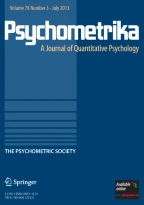Abstract
An analytic criterion for rotation is defined. The scientific advantage of analytic criteria over subjective (graphical) rotational procedures is discussed. Carroll's criterion and the quartimax criterion are briefly reviewed; the varimax criterion is outlined in detail and contrasted both logically and numerically with the quartimax criterion. It is shown that thenormal varimax solution probably coincides closely to the application of the principle of simple structure. However, it is proposed that the ultimate criterion of a rotational procedure is factorial invariance, not simple structure—although the two notions appear to be highly related. The normal varimax criterion is shown to be a two-dimensional generalization of the classic Spearman case, i.e., it shows perfect factorial invariance for two pure clusters. An example is given of the invariance of a normal varimax solution for more than two factors. The oblique normal varimax criterion is stated. A computational outline for the orthogonal normal varimax is appended.
Similar content being viewed by others
References
Carroll, J. B. An analytical solution for approximating simple structure in factor analysis.Psychometrika, 1953,18, 23–38.
Ferguson, G. A. The concept of parsimony in factor analysis.Psychometrika, 1954,19, 281–290.
Holzinger, K. J. and Harman, H. H.Factor analysis. Chicago: Univ. Chicago Press, 1941.
Kaiser, H. F. An analytic rotational criterion for factor analysis.Amer. Psychologist, 1955,10, 438. (Abstract)
Kaiser, H. F. Note on Carroll's analytic simple structure.Psychometrika, 1956,21, 89–92.
Kaiser, H. F. The varimax method of factor analysis. Unpublished doctoral dissertation, Univ. California, 1956.
Neuhaus, J. O. and Wrigley, C. The quartimax method: an analytical approach to orthogonal simple structure.Brit. J. statist. Psychol., 1954,7, 81–91.
Saunders, D. R. An analytic method for rotation to orthogonal simple structure. Princeton: Educational Testing Service Research Bulletin 53–10, 1953.
Thomson, G. H.The factorial analysis of human ability. (5th ed.) New York: Houghton Mifflin, 1951.
Thurstone, L. L.Theory of multiple factors. Ann Arbor: Edwards Bros., 1932.
Thurstone, L. L. Primary mental abilities.Psychometric Monogr. No. 1, 1938.
Thurstone, L. L.Multiple-factor analysis. Chicago: Univ. Chicago Press, 1947.
Author information
Authors and Affiliations
Additional information
Part of the material in this paper is from the writer's Ph.D. thesis. I am indebted to my committee, Professors F. T. Tyler, R. C. Tryon, and H. D. Carter, chairman, for many helpful suggestions and criticisms. Dr. John Caffrey suggested the namevarimax, and wrote the original IBM 602A computer program for this criterion.
I am also indebted to the staff of the University of California Computer Center for help in programming the procedures described in the paper for their IBM 701 electronic computer. Since their installation is partially supported by a grant from the National Science Foundation, the assistance of this agency is acknowledged.
Rights and permissions
About this article
Cite this article
Kaiser, H.F. The varimax criterion for analytic rotation in factor analysis. Psychometrika 23, 187–200 (1958). https://doi.org/10.1007/BF02289233
Received:
Revised:
Issue Date:
DOI: https://doi.org/10.1007/BF02289233
